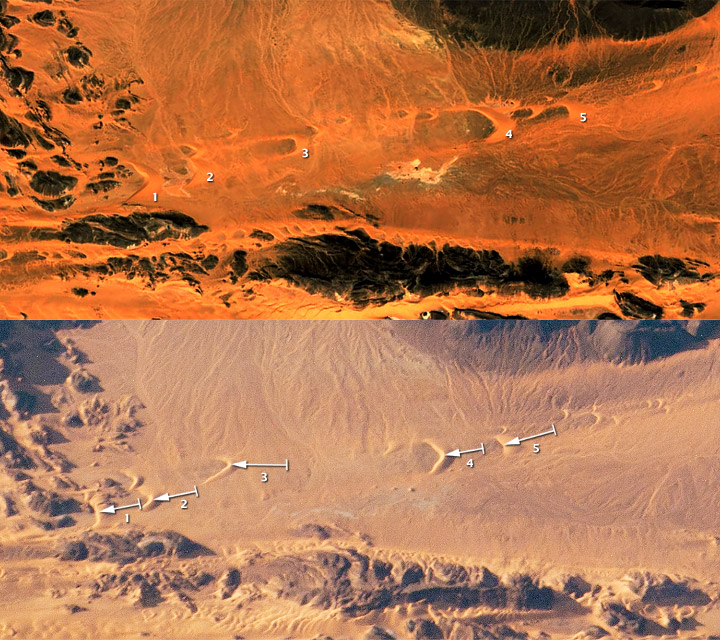


The Aorounga impact structure in northern Chad is 12.6 kilometers (7.8 miles) in diameter, large enough to display a central peak and more than one concentric ring. This eroded remnant of a crater (top photo) in Africa’s Sahara Desert is estimated to be less than 345 million years old. Astronauts have photographed it several times over the years, most recently in 2009 and in 2011. But it’s not the crater itself that caught our eyes this time. It is the sandy landscape around it.
Images of the central Sahara Desert taken from the International Space Station (ISS) often include sand dunes. The middle and lower images above feature a series of horn-shaped “barchan” dunes clustered in a narrow corridor between lines of dark-toned hills. (The white box in the top image marks the area depicted in the closeups.) The horns point in the direction of dune migration; that is, from north-northwest to south-southeast under the influence of the prevailing winds. Thick zones of rippled, light-toned dunes are visible at the bottom of the images, with dry river channels in the center and upper parts.
The larger dunes maintain their shape and size well enough to be identified in these images taken nine years apart. The 2003 image (middle) was obtained from Google Earth (©2013 CNES/Spot Image, ©2013 DigitalGlobe), while the 2013 photo (lower) was taken by an astronaut onboard the ISS. Comparison of the 2003 and 2013 images shows that five larger dunes appear to have moved, as seen against fixed points such as hills and channels. Measurements show that the dunes have moved hundreds of meters (#1 moved 316 meters, #2 moved 275 m, #3 moved 405 m, #4 moved 318 m, and #5 moved 381 m). Arrows show the direction and distance of movement.
Dunes 3 and 5 have moved furthest, following the well-known phenomenon that smaller dunes move faster. The smallest dunes move so fast that they cannot be tracked over a decade—because they are absorbed by larger dunes; because they move into hilly terrain and break up; or because newer, small dunes are shed from the horns of the larger dunes.
The opportunities for comparisons of the landscape are growing with each new year that we send humans and satellites into space. The imagery is quite valuable to remote-sensing scientists. For example, where large masses of sand move across highways or into farm fields, as is common on the edges of deserts, they cause great environmental damage and cost. With comparative imagery, it is now possible to predict when dunes are likely to cause such damage so that mitigation efforts can be put in place.
Astronaut photograph ISS034-E-70070 was acquired on January 6, 2013, with a Nikon D3X digital camera using an 800 millimeter lens, and is provided by the ISS Crew Earth Observations experiment and Image Science & Analysis Laboratory, Johnson Space Center. The image was taken by the Expedition 34 crew. It has been cropped and enhanced to improve contrast, and lens artifacts have been removed. The International Space Station Program supports the laboratory as part of the ISS National Lab to help astronauts take pictures of Earth that will be of the greatest value to scientists and the public, and to make those images freely available on the Internet. Additional images taken by astronauts and cosmonauts can be viewed at the NASA/JSC Gateway to Astronaut Photography of Earth. Caption by M. Justin Wilkinson, Jacobs at NASA-JSC.